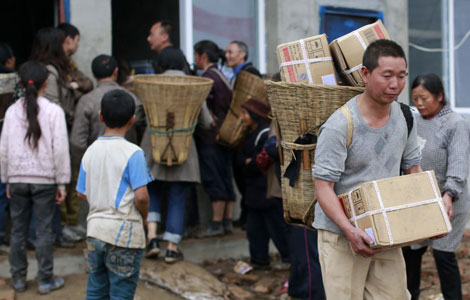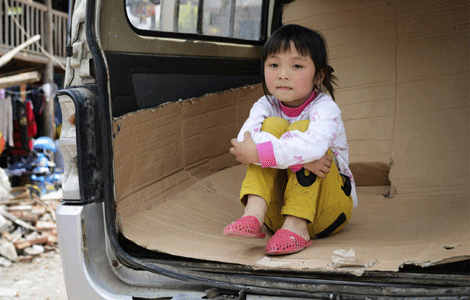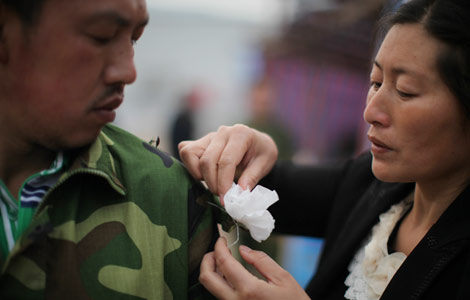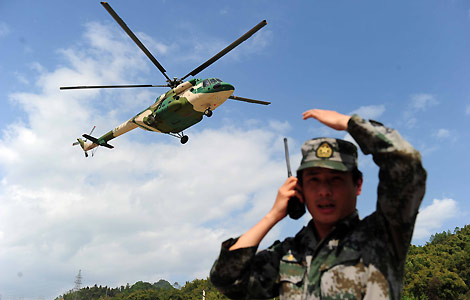Disasters put traditional media under more pressure
Updated: 2013-04-29 12:19
By Bai Ping (China Daily)
|
||||||||
You must have seen the Chinese television journalist who, dressed in full bridal finery complete with a veil, reported the strong earthquake that struck near her town in Sichuan province last week?
In a video that went viral on the Internet and appeared on some major international networks as well, Cheng Ying, the journalist, interviewed residents in the streets after the magnitude 7.0 quake shook the nearby Lushan county.
However, some people have taken her seemingly extraordinary dedication to journalism with a pinch of salt. How come Chen did not have time to change her gown and take off her veil when she had enough time to find a mike with her TV channel logo on it? And how did she continue her wedding party afterwards amid gruesome personal accounts about the disaster that soon trickled into Chinese social media?
The episode shows the lengths journalists can go to for grabbing more eyeballs by being the first to reach the scene of a disaster. It probably also illustrates the mounting pressure on traditional media from social media, because millions of people now share information on micro blogs or instant messaging apps, often long before they can get it from television or a newspaper.
Six minutes after the earthquake struck and hours before Chen's story went on air, a survivor at the epicenter had already broken the news by tweeting on her smartphone: "I thought I was going to die! Its epicenter must be in Lushan. My house has already collapsed." In less than two days, while journalists scrambled to provide information or were still on their way to the spot, weibo, the most popular micro blog platform, had generated about 70 million tweets that discussed every aspect of the earthquake.
Owing to its powerful crowd-sourcing capability, social media has also been used to collect information and data for rescue efforts in Lushan, a key role that largely fell on traditional media until five years ago when an even more destructive earthquake hit Wenchuan in the same province and when social media was a novelty in China.
Weibo claims to have more than 500 million subscribers while WeChat, the most popular instant messaging app that helped people connect with victims in Lushan, boasts 300 million.
So what's next for traditional media as they seem to be losing the race to be the first to report an event and slipping in their role as the key disseminator of real-time information during disasters? Perhaps they should focus on quality journalism that is accurate and digs beneath the surface to help present the full picture.
While Chinese social media helped to save lives in Lushan, they were also fraught with hyperbolic trivia, inaccuracies and even hoaxes. But most tweets exploded onto the national scene only after their veracity was verified and investigated by traditional media. Traditional journalism will survive if it continues to have credibility and attempts to provide all the facts.
The rise of social media may also prompt media managers to take their reporting to higher levels. Many traditional media organizations have been enthusiastic about instilling in journalists the art of news narrative that focuses more on appealing to readers' senses than substance.
Also, traditional media should re-examine their propensity for dispatching to disaster areas large numbers of journalists, who in their quest to know the details could torment survivors and increase their distress.
In the past week, traditional media organizations have sent more than 1,000 journalists, including 170 from overseas, to mountainous Lushan, allegedly causing traffic jams and other disruptions and creating hurdles for rescue operations, according to local officials, who have been urging journalists to leave as soon as possible.
Perhaps traditional media should thank the tweeters if their disaster reporting improves and doesn't become a media circus.
The writer is editor-at-large of China Daily.
Most Viewed
Editor's Picks

|

|

|

|

|

|
Today's Top News
Chinese NGOs reach out to African countries
Abe defends shrine visits
Premier Li: 'High alert' to remain on bird flu
China to enhance ties with Argentina
Technology fair eyes innovation
'Wang-Koo meeting' anniversary marked in Taipei
China joins rush for Mars
A camper's life traveling the open road
US Weekly

|

|














